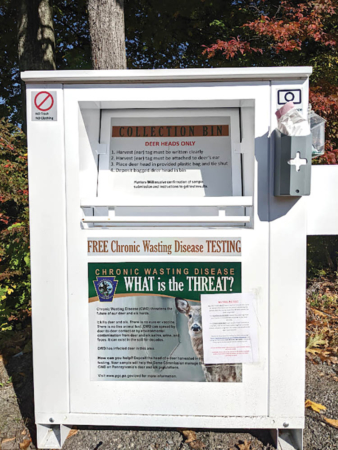I’ll be honest; writing about Chronic Wasting Disease (CWD) is not necessarily a story I enjoy penning. I know I wrote about CWD in a column back in September, but I was again reminded of the disease as my wife and I pursued antlerless deer during the special three-day season this past Thursday, Friday, and Saturday. I was again reminded of the unpleasant dilemma we deer hunters face when I stopped off at the local recycling center just outside of Muncy and spotted the unique container placed by the Pennsylvania Game Commission.
The metal bin is clearly labeled and has complete instructions for hunters who want to have their deer checked for CWD. So far, this is the only drop-off bin I have seen, but the Game Commission has placed these drop-off bins in all of the areas where CWD has been found. Bear in mind when dropping off a deer head, it must be double bagged with the tag attached. There is no charge to have your deer tested; hunters can access results online or by calling 1-833-INFOCWD.
I won’t get into all the details of CWD here since I already covered a lot of that in the September article but remember, hunters within the state’s DMAs are prohibited from transporting the high-risk parts of a deer outside the DMA’s boundaries. High-risk parts include the head, which includes the brain, tonsils, eyes and any lymph nodes, spinal cord/backbone, spleen, and anything containing visible brain or spinal cord tissue.
It’s been ten years since the disease first showed up in Pennsylvania in a captive deer herd, and while there is still no treatment or vaccines, research and monitoring of the disease are still being very actively pursued. In addition to the special DMA units that have been established and the special restrictions regarding the transportation of certain parts, there may be more changes on the way. One new regulation could be a statewide ban on using and possessing cervid urine-based products. These products are often widely used by hunters, especially archery hunters, to hide human scent and to provide an attractant to bring bucks closer.
Clearly, it’s important that we do all we can to limit the spread of CWD since it not only affects our deer herd but it could certainly also spread to our much more limited elk herd. It’s been a real treat for many, me included, to have the opportunity to bag a nice bull elk right here in Pennsylvania, and I would hate to see the herd reduced by CWD to the point where we could no longer hunt them.
CWD is spread directly through animal-to-animal contact and indirectly by contaminating food and soil with bodily excretions, which include feces, urine, and saliva. Deer numbers can obviously have a lot to do with how quickly the disease can spread. Game Commission tests have shown that in 2018 5.5 percent of hunter-harvested deer were affected by CWD. In 2019 that number had risen to 19 percent; a good reason for concern.
Exactly where we go from here is hard to say; research is being done to develop live-animal tests, creating a field test for hunters to use immediately and even using dogs to detect CWD through deer feces. You can also expect that limiting the deer herd and increasing opportunities to take more deer will also be a part of what’s to come.




